Ammar in the Polish wardrobe: A story about hiding refugees on the Polish-Belarusian border
She called briefly. I heard: “Come.” She couldn’t say anything more over the phone. I reached her an hour later.
“If you had seen what he looked like…” Beata takes a drag on her cigarette. We stand on the doorstep, smoke wafting inside. It’s minus 12 degrees outside, typical for February. Beata is shaking with emotion. She lives here alone. The house stands in a pseudo-exlusion zone, according to the law. We met two days ago. I didn’t expect her to call.
Beata can’t sit down. She walks over to the balcony window and taps on the glass.
“I was sitting in the armchair where you are and looking at the TV. I don’t watch that dumb TV, but I was thinking about what else I should do today. I heard soft thumps. I thought Karinka wanted to scare Grandma. I opened the balcony and then behind the railing I saw… I wish I had taken a picture. He had rubbish bags on his shoes. And he was all wrapped up in plastic. Not thermal blanket, but just ordinary foil, the kind used to wrap windows. I said, come and sit down. And he shows that he doesn’t want to sit down.”
“I didn’t want to sit down because I was all wet. I looked terrible.” Ammar suddenly joins the conversation, as if he understands everything. He already has dry clothes. He has managed to get warm, but he is still scared. He takes his phone, brings up the map app.
“There were four of us. We were sitting here hidden in the bushes, then suddenly soldiers appeared. They shouted: ‘Stop, stop!’ I ran ahead until I found myself at the river. I thought, since the water was frozen in the forest, the river will be too.”
Ammar looks at the map and takes a drag on his cigarette.
“If only I had known the water was so deep and rushing. I had to swim, I kept repeating in my mind: ‘God, why?’ When I got ashore, I no longer knew where I was going. The phones got wet. I felt that it was the end. That I was dying. I just kept walking ahead. Over the bridge, through the village, it was all the same to me, it didn’t matter if I got caught. At the first house the door was opened by a girl, she started shouting: ‘Mum, Mum!’ I ran away. Then I got here, I saw the lady watching TV. I knocked.”
Ammar talks about his older sister, who accompanies him in all the important moments of his life. She knows everything about him. It is also now that he is trying to reach her. She is the first person in the family to hear from him “I almost died. Tell everyone I survived, I’m healthy. I ended up in a home where they help people. I’m in a safe house.”
“Safe house” is what activists on the Polish-Belarusian border call the places where refugees find relief. Where no one will call the Border Guard. Some used to do that because they thought it was the right thing to do. Now they know that a single phone call might become a sentence. It would mean that the refugees are going back to Belarus, being pushed back through the border wire.”
Beata also called.
“It was September, there was a lot of fear. They imposed a state of emergency. The Border Guard instructed people: call.”
Beata suspends her voice and repeats several times: “Yes, I called, I admit it.”
I know what she is thinking now. She has already told me about an Iraqi family who ended up in her house for a few hours in the summer. That was enough to get them international protection. Then she called the guards. They should have taken the refugees to a centre, but instead they took the family “out to the wire”.
Beata cried as the little children called later from Belarus, asking, “Why did you do this to us?”
“I didn’t know they were going to deport them. They thought, and so did we, that if we got them international protection, nothing would happen,” she told me through tears.
Beata’s son managed to contact that Iraqi family. He also found their belongings, which the Border Guard had dumped in the forest.
Beata still has the little Iraqi girl’s backpack, her hairbrush and a small mirror. She repeats: “I look out the window and wait for someone to knock on my door.”
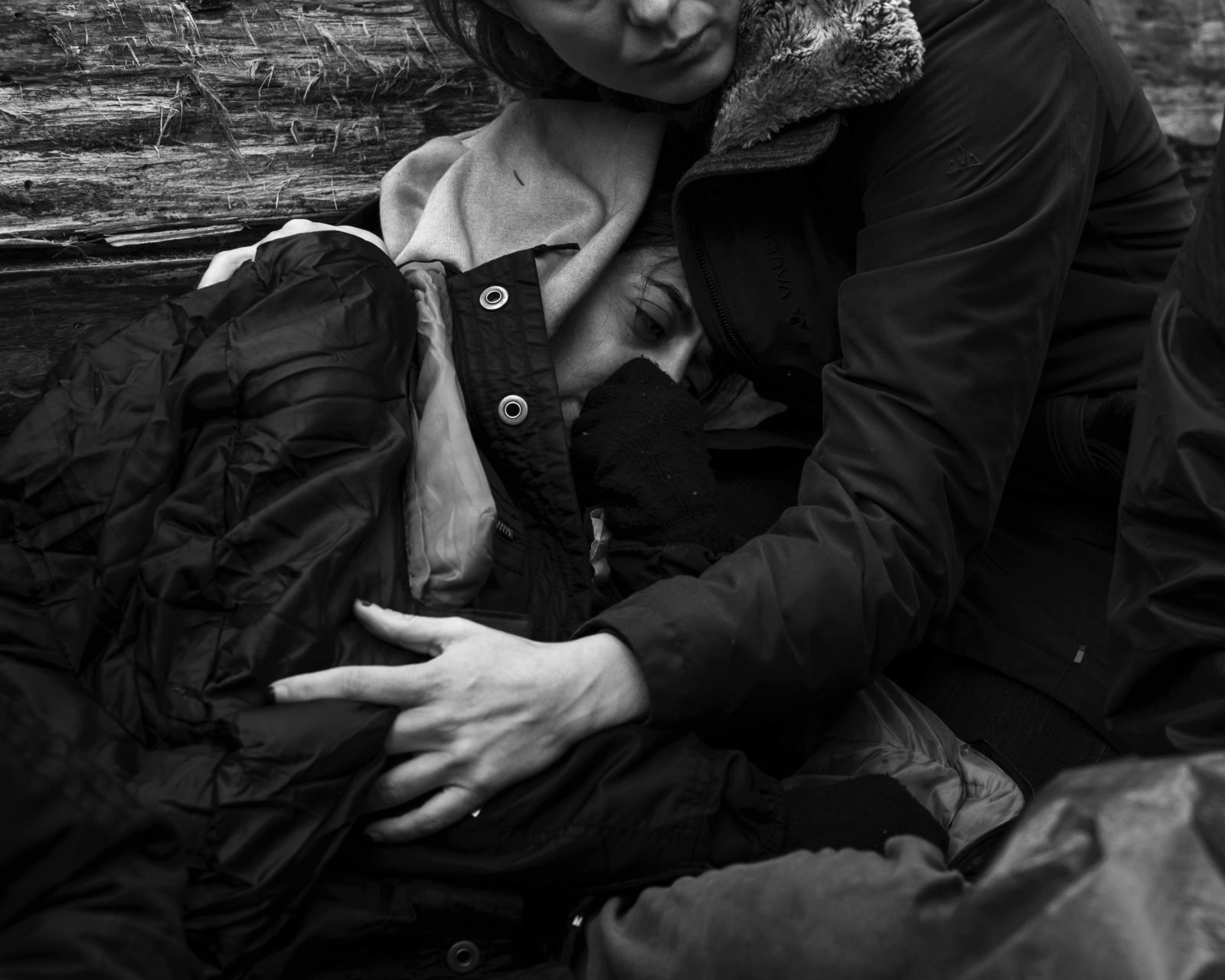
Avin and Ula, a refugee from Iraqi Kurdistan and a Polish activist, met during one of the Granica Group interventions. Poland 2021, photo by Karol Grygoruk.
Dehumanised people are easier to haul back to the forest
I arrive at the village of Z., assisted by the Border Guard. Apparently, the officers have received information that a car with Warsaw plates is loitering in the area. There are still a lot of patrols here, a lot of army presence.
Almost nobody calls the Border Guard in this village any more. Not even those who at first were afraid to give a refugee a glass of water just because the border guards had declared that it was illegal to help. And those who did help were afraid to admit it. They kept silent or said: “Refugees? They were at a neighbour’s house, not at ours”.
An activist, who I travelled with in late October and early November, tempers: “I sense that it wasn’t the neighbour who had these refugees, though. It’s like during the war, the helpers are afraid to admit that they have been helping.”
After several months of border crisis and anti-refugee propaganda, the people of Podlasie know who to call when they meet foreigners. In the village of Z. they call Kasia and Tomek.
“When you welcome someone at your home, so that they can to get warm, have some food and rest, you are acting legally, it’s humanitarian aid”, Tomek explains. “But when you think how to put it into practice, the stumbling blocks start. Because people have different neighbours, and neighbours have different views. And how, for example, to tell refugees where the safe house is? When you go with them through the forest, for law enforcement you might be a guide or a smuggler. The refugees have to reach the house on their own. We won’t put them in a car and transport them. It’s impossible, it’s illegal,” says Tomek.
But then these people are usually between a rock and a hard place. So some things happen spontaneously and that’s that. A person takes risks. Even when faced with the danger of being arrested. Simply because others are threatened with deportation.
First time they took refugees home was in November. What were they supposed to do? Two guys completely emaciated, a shivering woman and these children. The boy was crying all the time.
“I didn’t even think we might be in danger. I was worried about them. I felt tense the whole time. My neck was straining and I was walking around aching all over. I don’t know why,” Kasia recalls.
“Because we live in war-like conditions”, Tomek says. “Hiding people is stressful. Maybe there are no battles, no threat of the death penalty, but when this harbouring of people goes on for a while, as it has recently, the stress level becomes unacceptable.”
Our conversation is interrupted by an elk outside the window. Bison are no longer so impressive, the herd often comes into the meadow near the house.. But the elk is an unusual visitor. Tomek asks Kasia if she can talk about the unromantic side of hiding people.
“Yes, because it shows the scale of the debasement,” says Kasia. “When you find them in the forest, it’s obvious they are dirty, they have been there for weeks, after all. But when they enter a house…” Kasia searches for words. “For an ordinary person who doesn’t deal with people in crisis situations, this is terribly hard. Both for them and for us. Because they also feel what we feel.”
Tomek joins in: “One Syrian man told me that his children had not been bathed for six weeks. Anyone who reads this can imagine themselves how they would feel after six weeks in the forest without a bath. The activists and I helped repack one woman’s belongings in the forest. Between her clothes I saw a cable. I pulled, and at the end… ‘Oh fuck, a hairdryer!’, we cried out together. Not very serious words, contrary to the matter. They are lugging this hairdryer around so as not to lose their dignity. After all, they didn’t think they would be stranded with a hairdryer in the forest.”
“But once they come out washed and clean, they are beautiful. The woman who was with us had beautiful long hair. When she left us, it was blowing wonderfully in the wind,” smiles Kasia.
“This shatters the image of a refugee that ordinary Poles have,” says Tomek. “Because a Pole might accept a dirty, barefoot, bedraggled person. But then if he has normal shoes, a phone and a suitcase, he is no longer a refugee, but an economic migrant. It doesn’t matter how many bombardments he has survived, how many loved ones he has lost, how many wounds he has suffered from. The guards would rather have these people dehumanised. It is easier to deport them to the forest. They prefer humans not to look like humans.”
Is there a limit to helping?
Kasia and Tomek have welcomed refugees into their home five times. The first family – a Kurdish one – spent five days.
“There was a constant hustle and bustle. The children were rushing around, the stories were flying, and they were doing nothing to end their stay with us,” Tomek recalls.
“You don’t know that,” remarks Kasia.
“I know it, and you know it too.”
“Well, maybe. But it’s a different situation than with the Sleepyhead.”
“We had two Syrian men and an activist living with us at the time,” Kasia recounts. ” We go out in the morning and, here you are, someone’s sleeping on the stairs by our front door. We wake him up. The man still has the bristle, while the two others at home are already clean and shaven. He said he knocked during the night, but no one heard him. Anyway, he stayed with us for almost a week. Most of the time, he just slept and, generally did nothing to organise his transport. He explained that he had no money. Or that his brother from Berlin would come. Finally, Sleepyhead’s father started calling us from Iraq, asking to find him a smuggler. He said: ‘Only to Warsaw, I can manage further’. And you feel this pressure. You do everything you can to help a person, but gosh, the awful thing is that you have to learn to put up boundaries. To learn to say no. It’s very difficult. They don’t understand that we can’t get them transport. They ask and they have no qualms, well, because they are fighting to survive. They are not guided by convention or good manners. They won’t say, ‘Oh I think I’ve been with you too long’. And I understand this very well. I would probably function that way too.”
Kasia and Tomek’s guests usually leave quietly. They agree that this is the moment and leave. Only once, when this first Kurdish family was leaving, did Kasia cry. Out of emotion but also relief. After so many days of tension, they finaly left. And not into the forest.
She took him by the hand, they walked like a couple
Anna knows that many would like to help, to welcome someone in need into their home, but not everyone can.
A flat, for example, is out of the question – too many neighbours and people who might “see something”. There are some houses that seemingly might work perfectly, but the neighbours are untested. Or outright hostile. That does not leave many options.
Residents in the zone opened their doors when immediate help provided on the spot, in the forest, started to prove ineffective. That the people they were finding were often hypothermic and needed to rest in decent conditions; when there were more and more pushbacks and deaths; when they realised that calling an ambulance could cause harm – as you cannot be sure whether the ambulance comes or not, but the border guards notified by the doctors certainly will. So the best thing to do is to take the person home. It is a human reflex impulse.
Anna received a text message: “There is an Iraqi man in the town centre. He’s sitting in the park. What should we do with him?”. She wrote back: “He needs to be hidden, I’m on my way to get him.”
A man was roaming around for days, with no food and no water. Completely alone. From time to time he would join some groups. One of them was caught in the forest. He saw them being picked up by people in civilian clothes, while a police car was parked on a side path. First he fled through the woods, but eventually he decided to go into town and see what would happen. That was when Anna’s friend saw him, in the park. She took his hand and walked with a confident step. They looked like a couple. The street was almost empty. A hooligan sitting in front of a block of flats was given 20 zloty not to tell anyone what he had seen. Anna was waiting behind the corner. The guy had his cap slipped down and his face covered with a scarf so that it wouldn’t be obvious he was darker than everyone else. He was frightened. They got into the car.
Anna remembers that as soon as they entered the house, Ali asked about the shower. He wanted to wash off the smell: damp, smoky, unwashed, very strong, Anna already knew it well.
After getting washed he immediately looked much better. He was very young. He said his journey had been a must because in Iraq he wanted to commit suicide in Iraq. Everything seemed pointless. That’s what Anna understood. And then someone told Ali about going for a better life through Belarus. He didn’t check if it would be difficult. A wave carried him until he ended up in the forest.
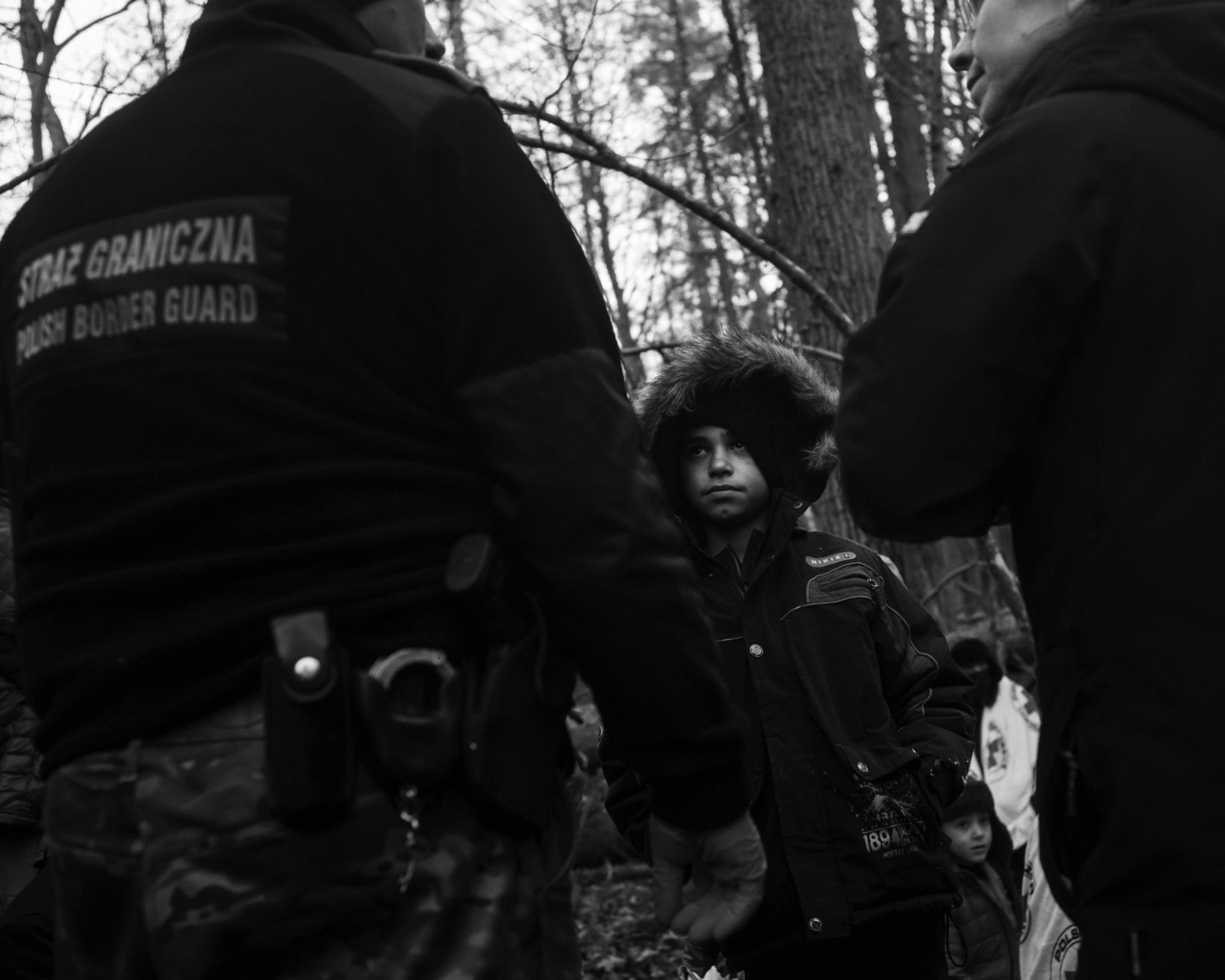
Azyar (11 years old) from Iraqi Kurdistan detained by the Border Guard. His entire family of sixteen was pushed to the Belarusian side several times. Poland 2021, photo by Karol Grygoruk
The camel in the kitchen
After Ali, Anna had eighteen other guests.
“At first they are very intimidated. They find it a bit hard to understand who I am or why I’m helping them. And then they go to sleep. In the morning, rested, they get back their colour,” says Anna. “You know, in a person you can see how they regain colour. In the face, in the clothes, in the flash of the eye, in their voice. One day later they start joking around, talking about themselves. After all, they all have their lives, their stories, just like anyone else. And not just tragic ones. They show pictures of their homes, their families, their daily lives. They want to manifest what they are like and that they have achieved something.”
We were seated at the table where Anna spent many hours with her guests. They talked in English and via translation. Once, she had to draw pictures, such as a car and with gestures tried to explain that she was going somewhere, as her guest spoke only Sorani, which Google Translate doesn’t know. At least not at that time.
Once at Anna’s table, somebody said: “I understand perfectly well what you are doing here. If I could stay, I would do that and help, just like you. Because that’s what I did in Syria.” He had a restaurant there, he gave back to people who had lost their homes.
At that table the guests would eat scrambled eggs together. A Cameroonian would make them for a Moroccan. And in the meantime, they would exchange stories about the right way to kill a camel so that it is halal.
And there, in the corner of the room, is exactly where they would pray. Anna fixed the direction according to the movement of the sun. To check if it was right, Ali pulled out his phone with a special app with a compass for Mecca and asked for two green tree leaves. She did not understand why he needed them. He put them on the floor and said it was instead of a prayer rug. He knelt on them. “When he left, I went into this room, there were these leaves on a wooden stool,” Anna says.
Ali sent news back from the refugee centre in Germany. He had already had his second interview that might prove decisive for his future. But the people there did not believe his words. They said that with such tales he could go to Hollywood. Because why would you believe his story? He managed to cross the border because it was foggy. He joined a group that was picked up by people in civilian clothes. He was the only one who avoided the pushback. Why? And then, after four days in the forest, he walked into the city, and no one stopped him. Strange, isn’t it? Finally he sits down on a park bench and someone takes him home. And then he ends up in Warsaw, where someone protects him in their house. And then in Poznań too.
Such a story seems to escape the logic. And many of them are like that.
You’re not crazy, you’re saving our lives
Anna asks visitors: where did you get the motivation to do this? Did you never doubt that it made sense?
And yes, they all confirm they doubted every single day. One guest replied: “Without dreams you are dead. They give you direction. And no one can forbid us from dreaming.” He added: “Our country has only one thing for us, namely, war. And I too have only one thing, which is my life. And I do care about it.”
“I had the feeling that I was going mad,” says Anna. “That I’m giving my house away to strangers, squeezing my life to some vacant rooms, and still going to the forest in the meantime. That we’re practising a secret, underground state here, playing hide and seek or hare and hounds. None of these seemed normal. Therefore, sometimes I had the impression that our involvement verges on insanity. I told one of my guests about this sense of madness. His response was: ‘Don’t even think like that. You are saving our lives.’ I confided that I often come back home and cry. And he said: ‘Don’t cry. In our country we have to be strong, because if you lack strength, they kill you. But you have no reason to cry.’ I learned a lot at this very table. We save their lives, then they move on in the world. Yet, a bond remains, probably because we met in such a special situation, and also due to the fact that I know something about them that nobody else knows, not even their families.”
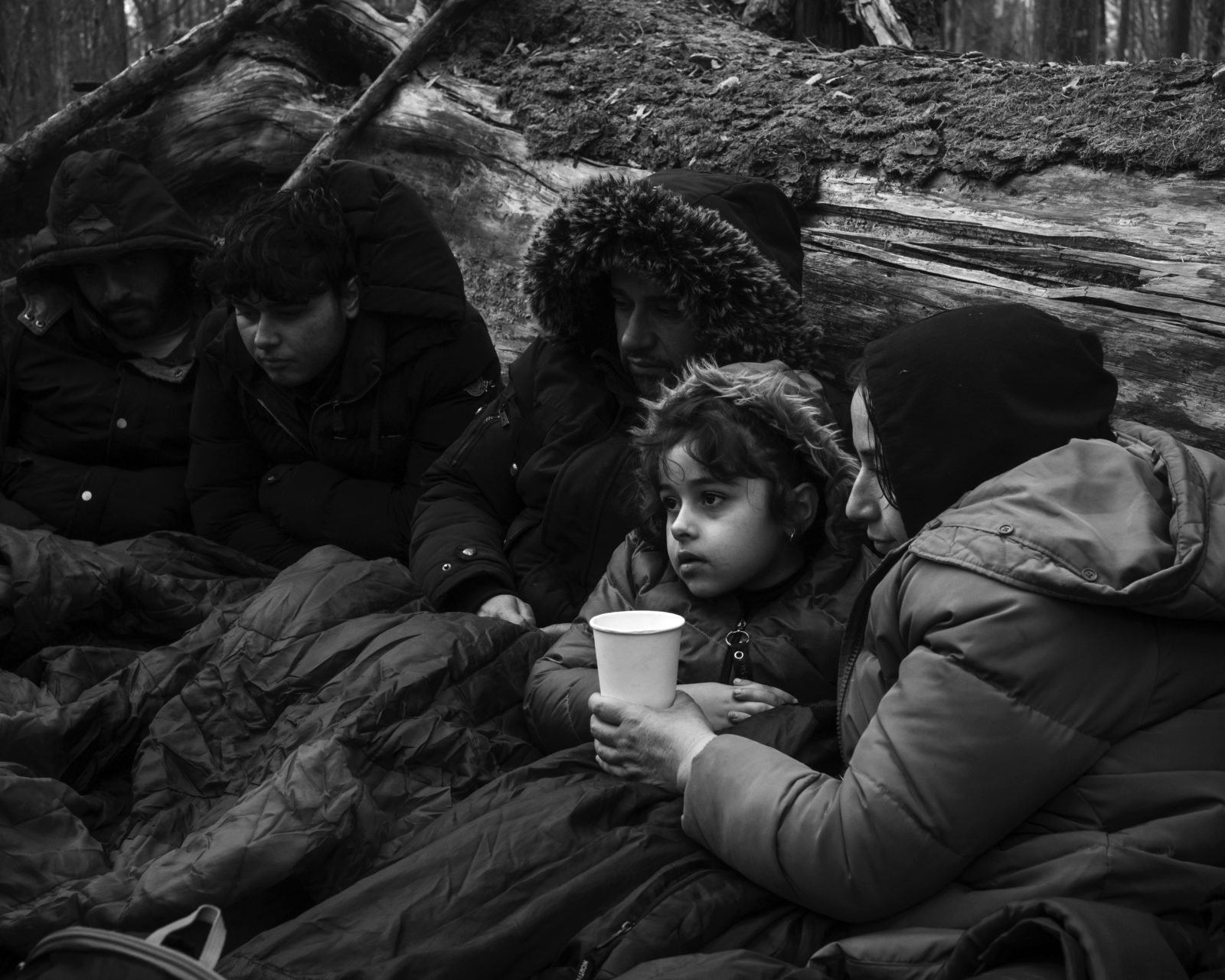
Amlad (25), Amad (15), Wadla (43), Elena (5), Kawsar (31), part of a family of nine from Iraqi Kurdistan. Today they have found a safe haven in Western Europe. Poland 2021, photo by Karol Grygoruk
First checkpoint, first lie
It was a Sunday in early September, beautiful sunshine. Dominika with her husband and son went to the forest. Not for a walk, because Dominika hates walking in the forest. They went because they wanted to help. In fact, the son wanted to. He packed a rucksack and shouted: let’s go.
They walked and walked. Nothing. Just when they were about to go home, something suddenly flashed by.
She remembers it well, her heart was in her throat. She said to her husband: “Let’s get the fuck out of here! I’m not going in there. I’m gonna have a heart attack and you’ll be looking for a phone signal to call an ambulance. I’m not going any further, I’m scared.” She was terrified, even though she could see just two young guys and a baby.
“Are you scared of the baby?”, asked her husband.
“Yeah, I’m going to go up to the baby, and thirty guys are going to come flying out. They’ll beat us up out here. We won’t even be able to call anyone because there’s no signal here.”
Her son turned on her: “Mum, at home you were so brave. To say that if you met someone, you’d help. And now you’re such a chicken.”
They approached. Three shivering little children asked for the internet. They didn’t want anything else. Just the internet. One spoke a little English, but poorly. Dominika thought: “Well well, then you’re at home. Because I also speak it very poorly, so we’ll get along.” She asked if there were any other children. There was another one. Together that made four: a talkative 10-year-old; a scared 15-year-old; a 17-year-old who seemed like he was the head of the family; and a 7-year-old child with autism.
They gave the kids food and some other stuff, but they kept going on and on about the internet. They wanted to contact someone to take them away. Getting people to a safe place with mobile coverage is not that easy. If someone sees them, guiding a whole gang, the game is over. How would they get out of that, explaining that they weren’t in fact smugglers? But Dominika knew she couldn’t leave them there. She said to her husband: “Show them the way.”
The boys managed to contact someone who promised to come and fetch them, but only in two days. Two days, goddammit! How are they going to manage with these children in the forest? We had to go and get more stuff. But then again, a car loaded to the ceiling with rucksacks, how do you get past the checkpoint with that?
“Where are you going?”, asked the policeman.
“To the mountains”, Dominika answered in a confident tone.
“And where are your skis?”
“Officer, it’s not worth dragging your skis with you these days. There are ski rental shops all around,” Dominika argued.
The policeman smiled and even wished her a nice holiday. Only her husband asked wryly: “So you’re going skiing in the mountains in September? And where will you get the snow from?
First checkpoint, first lie, thought Dominika. Later, after this first group, there would be others. Now, in mid-October the weather already got really cold. Leaving the children in the woods was out of question. It was simply impossible to walk away from them. She was scared as hell, because the army was everywhere, and she had to drive with the children from the forest through the very centre of the zone. Hardly had she set off, when an army vehicle came right behind. What bad luck, she thought, predicting that they would stop her. “I couldn’t feel the gas or the brake or anything. I was shaking all over.” But, fortunately, the army car disappeared around the bend. She stopped the engine, took a deep breath: “Get a grip. Your children are waiting at home. It’s only going to be a mess if you give up now.”
A dirty guy in the bathroom, a friend over coffee
Once they got back to Dominika’s house, it was strange. How to talk to them? How to behave? The first day was hard, and the first night too. Dominika was afraid: “What if we get our heads ripped off?” In the morning she said she had to go to work. She left the guests with her children at home. Her daughter remarked, “You’ve dragged in company and now you’re leaving, big thanks.” At work, she constantly kept thinking about them and could not concentrate. All in all, she decided to take a leave of absence.
They quickly learned to function together. The guests cleaned and cooked trying to show their gratitude. Their presence was not a burden. Worse were the people you had to hide them from.
Knock, knock. “Hi, I’m just stopping by for coffee”, said a friend on the doorstep. Oh shit, thought Dominica. The friend enters and starts chattering about the “dirty people”. That, fuck, they should be shot, a bullet in the head. And she is an educated girl. Dominika thinks patiently: let her have her coffee, as quick as possible, and get off. But the woman has one coffee, then another one, and keeps babbling, while Dominika’s guest is sitting in the wardrobe the whole time.
“I just thought to myself, God, how lucky it is that he doesn’t understand Polish. He would be upset. Because he’s just a person, the same as us. And the thought flashed through my mind: how about I tell the boy to come out? And I’ll show her: ‘Look, this is the dirty man you’re talking about. See how elegant he looks.’ Because they are indeed dirty, but only in the forest. Later, when they bathe, they start looking są good. Really, they are no different from us.”
Birthday wishes
At Beata’s house it smells of soup. The table in the living room is set with cakes and snacks. The previous night they didn’t get much sleep. Too many emotions.
We try to find out what happened to Ammar’s friends who stayed in the forest. But there is no contact with them.
We are joined by Robert, Beata’s son. He gives a matter-of-fact assessment of the situation.
“Ammar was not organised. I don’t know what he was hoping for, but certainly he had no big plans. Even if he hadn’t lost his phones in the river, I don’t think he would have known what to do next.”
Ammar tries to warm himself up by the fireplace. He calls, he writes, he tries to contact the people who are supposed to help him. He also shows the numbers of those who got through. Or of people who helped them get through. “They could be smugglers,” Robert says.
I ask him how long Ammar can stay with them.
“As long as he needs to,” says Robert. “You know, in fact, no one was waiting for him here. But it’s already happened, he’s with us. We can’t run away from it, can we? After all, if he hadn’t ended up here, if we hadn’t helped him, he’d probably be dead by now. There are many situations like this. We all face something new. At the beginning, in September and October, we felt the pressure of the authorities. There was a lot of fear, a sense of powerlessness, but eventually or maybe as a result, I decided to commit myself to helping in the forest.”
“Afterwards, I noticed that I had symptoms of post-traumatic stress disorder. I was afraid to go out into the woods. Now I don’t take it as hard, although I do get involved. For me, it’s a fight against the sick system. Because I know what will happen to these people if we don’t help them. I know what happened to the first family that came to us. Even though we offered protection for them, they were pushed back to the wire. I tried to find them but it didn’t work. Ammar is incredibly lucky. Most situations from the border are miraculous cases. Here, there are lots of stories that are hard to believe.”
Ammar stayed in Beata’s house for nine days. Robert sent me pictures. Their guest was no longer sitting hunched over by the fireplace, but smiling on the sofa. Shaved, he had regained his colour.
For another week we had no contact. Finally, he wrote: “Guess where I am?” He has reached Germany, he is in a refugee centre.
His sister’s wish came true. Exactly one year earlier, on his 29th birthday, she wrote: “I hope our dreams come true. Your heart deserves it.”
I asked what was his birthday wish that year.
“I wanted to reach a country where human rights are respected and where I would have influence on my future. It probably sounds trivial, especially for a person who has been guaranteed this since birth. You won’t understand if you don’t know what it’s like in the country I come from, in a country where there is war. For me, security, freedom and dignity are the most precious things. Without them, life is not worth living. That’s also why people die trying to cross the border. And a miracle happened, many miracles. Just when I thought I was going to die, I knocked on Beata’s door. For sure, what I expected more in the village was the police. They weren’t looking for me, it was me that was looking for them. But I ended up at Beata and Robert’s house and everything changed. I got a lot more from them than I would have expected.”
The names of the characters have been changed.
Translation by Voxeurop.
Mykolaiv
Mykolaiv spreads out around the silver mirror of the Southern Bug River. The bridge over the Bug is raised, lowered, raised again. Every day, buses full of women and children depart for Odesa, which remains safe for now, though some flee farther still, to Moldova or to those parts of Ukraine not yet subsumed by war.
There are Russian divisions twelve miles to the north and east. They are shelling the outskirts of town.
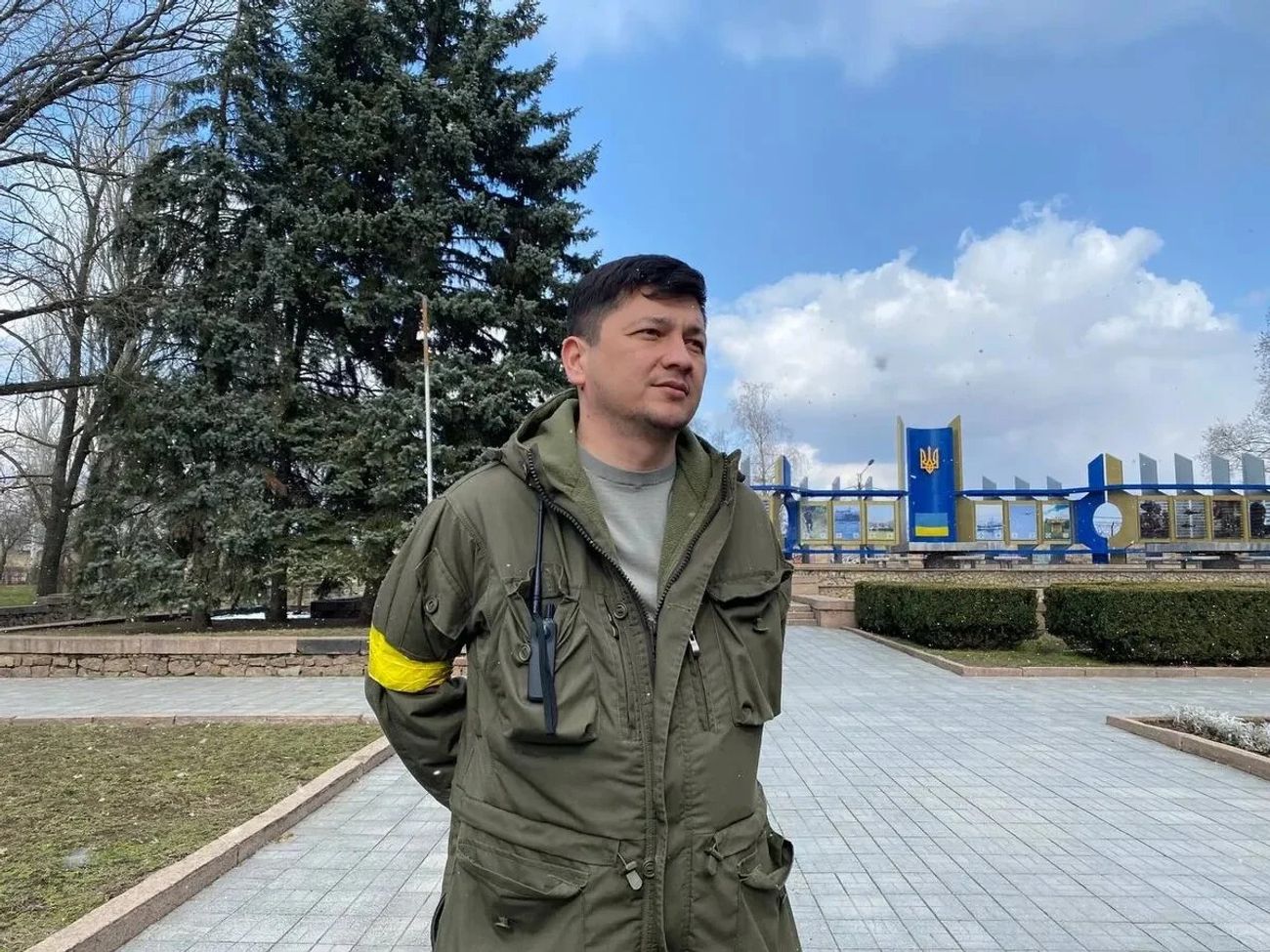
Governor Vitaly Kim
Elena Kostyuchenko / Novaya Gazeta
Mykolaiv operates in blackout mode, no lights allowed after nightfall. The city administration has warned that a single individual’s failure to comply will result in the electricity being cut off for their whole building. Only the grocery stores and pharmacies remain open. Schools and day cares have been on break since the war began; no one wants to separate children from the adults. Many of the bus routes have been canceled; some of the buses have been requisitioned by the army and others deployed in the evacuation.
There are heaps of car tires sitting at the city’s intersections, ready to be ignited when Russian troops enter the city. Some still bear traces of paint from when they served as decorative borders for municipal flower beds. “One useful thing about the war,” said the mayor, “is that at least we’ll get rid of the rubber swans.”
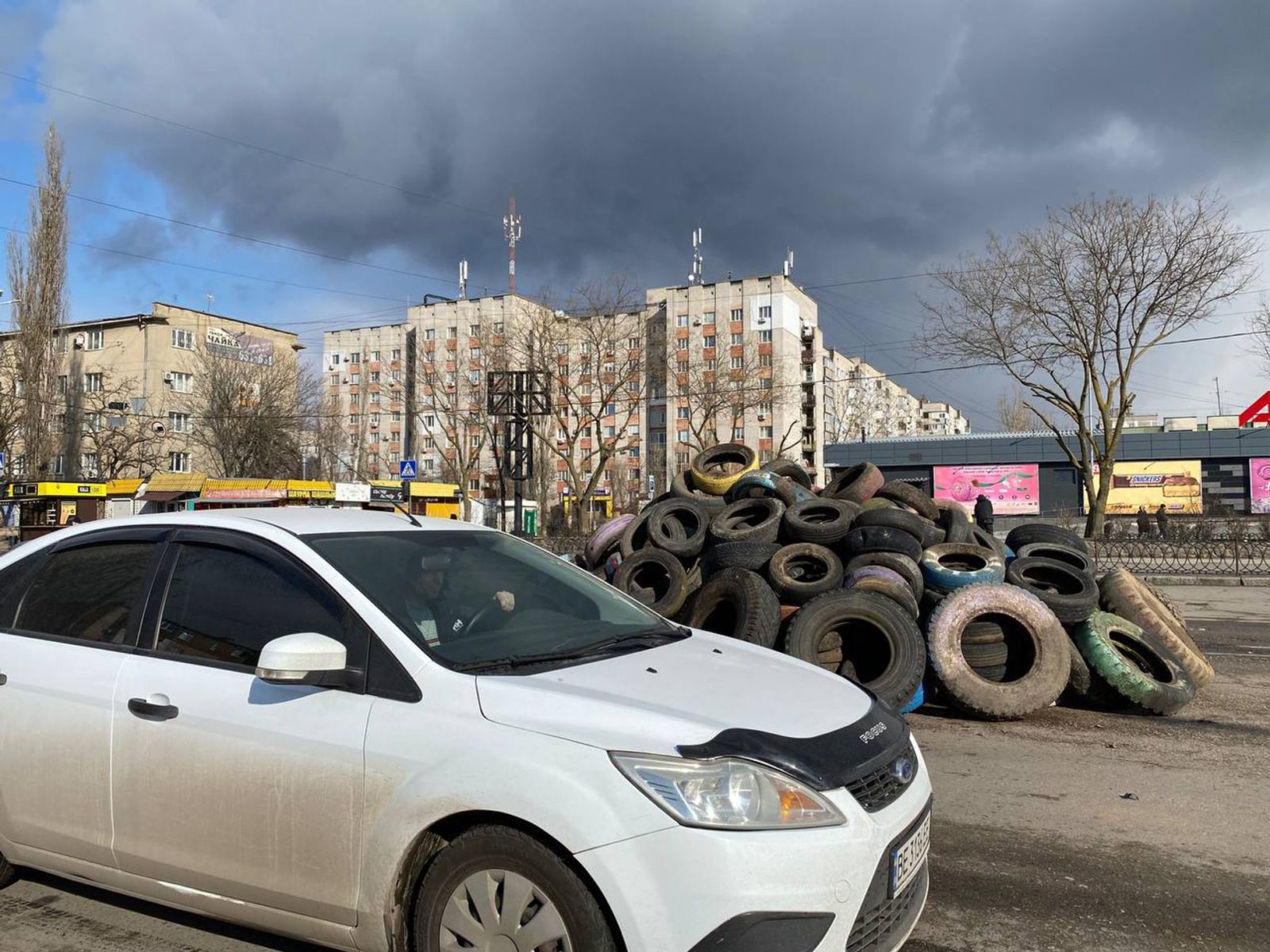
Nikolaev
Elena Kostyuchenko / Novaya Gazeta
The lines for humanitarian aid packages are orderly: grains, tinned food, butter.
Everyday life takes place between air raids. The trauma center has been converted into a field hospital. Patients are evacuated as soon as their surgeries are completed and their wounds are patched up. Beds are then quickly cleared for incoming patients. The medical staff lives on-site and have done so for the past two weeks, since the war began.
Humanitarian aid comes through Odessa. The bigger city watches Mykolaiv with awe: Odessans believe that Mykolaiv is the only reason Odessa has not yet been besieged.
“Mykolaiv is partially surrounded,” says Yaroslav Chepurnoi, press officer for the Seventy-ninth Brigade. “There are seventeen Russian battalion tactical groups [BTGs] positioned around town,” he says. “Say each one consists of approximately a thousand men: that means seventeen thousand soldiers and fifteen hundred units of military tech—weapons, equipment, vehicles. We don’t know their command center’s plans, obviously; we can only assume that some of these BTGs will go north, possibly to Kryvyi Rih. But some of them will stay back and storm the city. We know that the Russian command has been ordered to take Mykolaiv, that it’s been ordered to take Odessa, and probably also to punch a land corridor to Pridnestrovie. So we are building up our defenses. Each day that goes by while they wait to attack Mykolaiv we use to build up our defenses.
“The Russian troops attacked a few times already. Four times, I think. The first three were just to gather intelligence. They came in small numbers, and we repelled them, blew up their vehicles. . . But March 7 was a proper attack, with rockets and tornado missiles at first, then they threw two BTGs at us.
“Here’s something interesting. They had plenty of weapons and carriers, but all it took for them to turn back and retreat was our blowing up a few tanks and a couple of armored vehicles. As soon as they took a bit of damage, insignificant damage, they turned around and retreated. We were surprised, frankly. When you launch an attack with tanks and armored vehicles, you expect to lose a few of them in the course of fighting. That shouldn’t prevent you from pushing on.
“According to the official count, there are three thousand captured soldiers across Ukraine. I trust those numbers. Even here, there are dozens and dozens. A couple days ago, we had twelve people surrender after some fighting. The fighting was over, even.
“They’re shelling the city with Grads and Hurricanes and Tornadoes. Grads may be only 122 millimeters, but Hurricanes are 240 millimeters and Tornadoes are 320: these are all multiple-rocket launchers. At first they targeted military installations. On February 24, they shelled our military airbase at Kulbakino, but our planes were already gone, so no dice. On the evening of the fourth, they targeted the railway station and the fuel storage tanks. Then the bread factory—I mean, God knows what they’re thinking. . . . And then, on the sixth and the seventh especially, they started heavily shelling the military units, as well as just residential areas. They’ve already hit the water treatment plants on the outskirts of the city a few times, so we figure they’re trying to mess up the water supply for the civilians. They’ve stationed artillery in the towns and villages between Mykolaiv and Kherson, that’s where they’re launching from.”
Shells rain down on Khersonskaya Street. This is Balabanovka, a residential neighborhood on the southernmost tip of the Korabelnyi district. The homes are so badly damaged they look half built. Slate tiles blown off the side of a fence, roofs sliding down into craters. The streets between the houses are strewn with the detritus of everyday life. A wall has shattered into bricks, though a little sign with the building number—22—survived. There’s no glass left in the windows, which makes the buildings look abandoned. A crumpled Gazelle van sits stowed behind a green gate.
Beyond the gate, a vegetable garden, the earth recently plowed. A cherry tree, strafed to the ground, its branches scattered across the warm earth. There are three gaping holes in the attic roof.
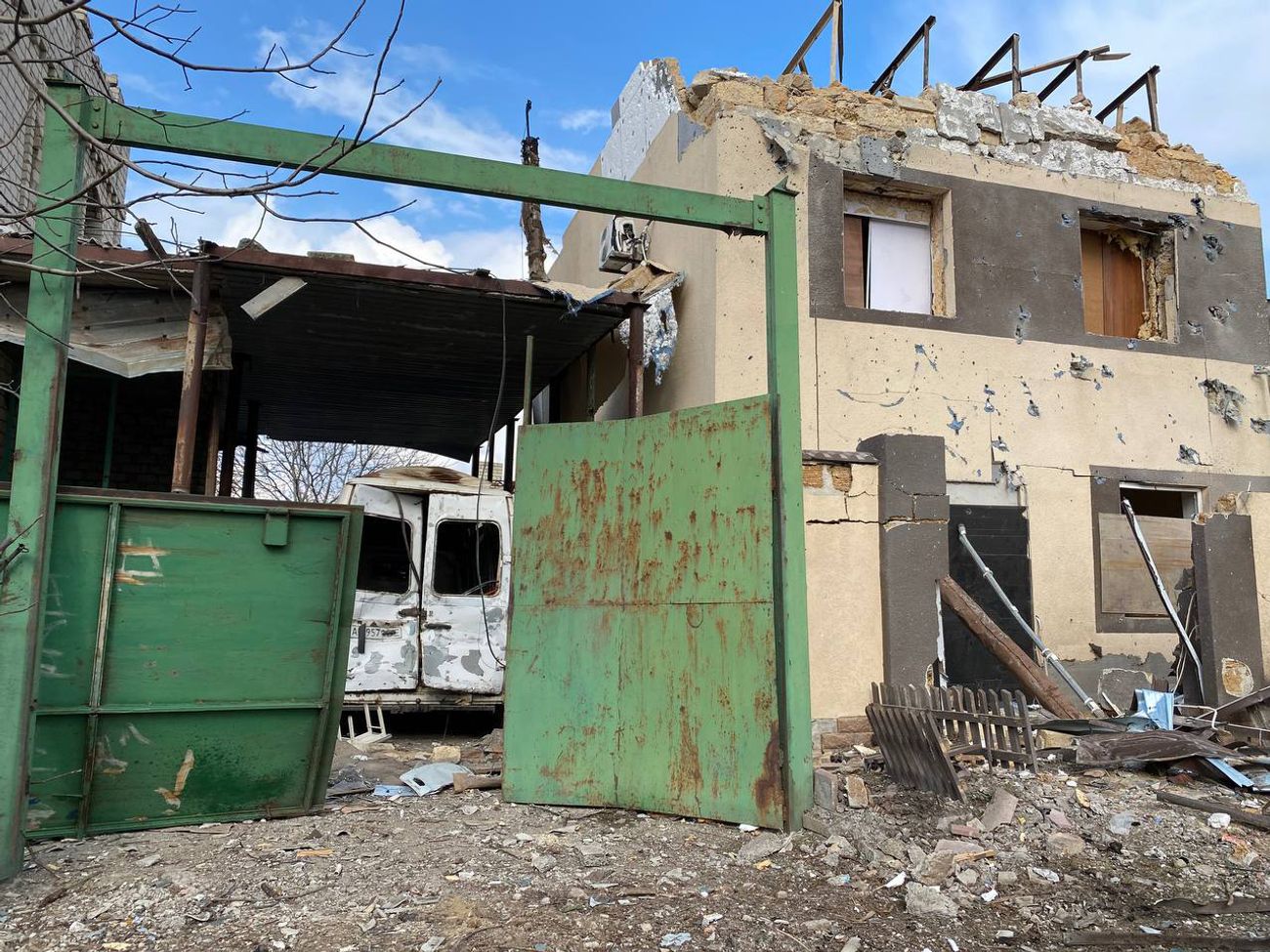
Consequences of shelling, Nikolaev
Elena Kostyuchenko / Novaya Gazeta

Sasha with a shell fragment in his hands
Elena Kostyuchenko / Novaya Gazeta
Sasha is up on a ladder, clearing the shattered slate tiles off the roof. He seems not to notice the tears running down his own face.
“First the shelling. A big whoosh over the wheat, all our windows blew out. Then it seemed to get quiet. My wife was on the porch, I was in the kitchen. She sits down. I take a look out the window and see these two airplanes from who knows where, black like the stealth ones. My wife fell over, and then rat-a-tat-tat! Some kind of white smoke. I threw myself over my wife and we started crawling. I’ve been picking up all the shards. Look how sharp they are, you can cut a person in half with that.”
His wife, Nadya, sits with her palms on her knees. “This is where I sat down. I was sitting right here. I’m sitting here, and there’s no sound at all. No sound for me to be afraid of. These two airplanes, they were scary, black or dark gray, but I didn’t even move from where I was sitting. I thought, ‘They’re not going to bomb civilians.’ And right at that second they started in on the ceiling. . . . I can’t tell you how terrifying it was. . . . Look at the gate, all the holes. Another moment, and that would have been me. I’m still in shock, I still can’t feel my legs. I’m terrified. Because the idea of leaving is terrifying, too. You still have to make it somewhere. This family I saw on the news, they were fleeing and they got caught in an air raid. The children died, and the parents, everyone.”
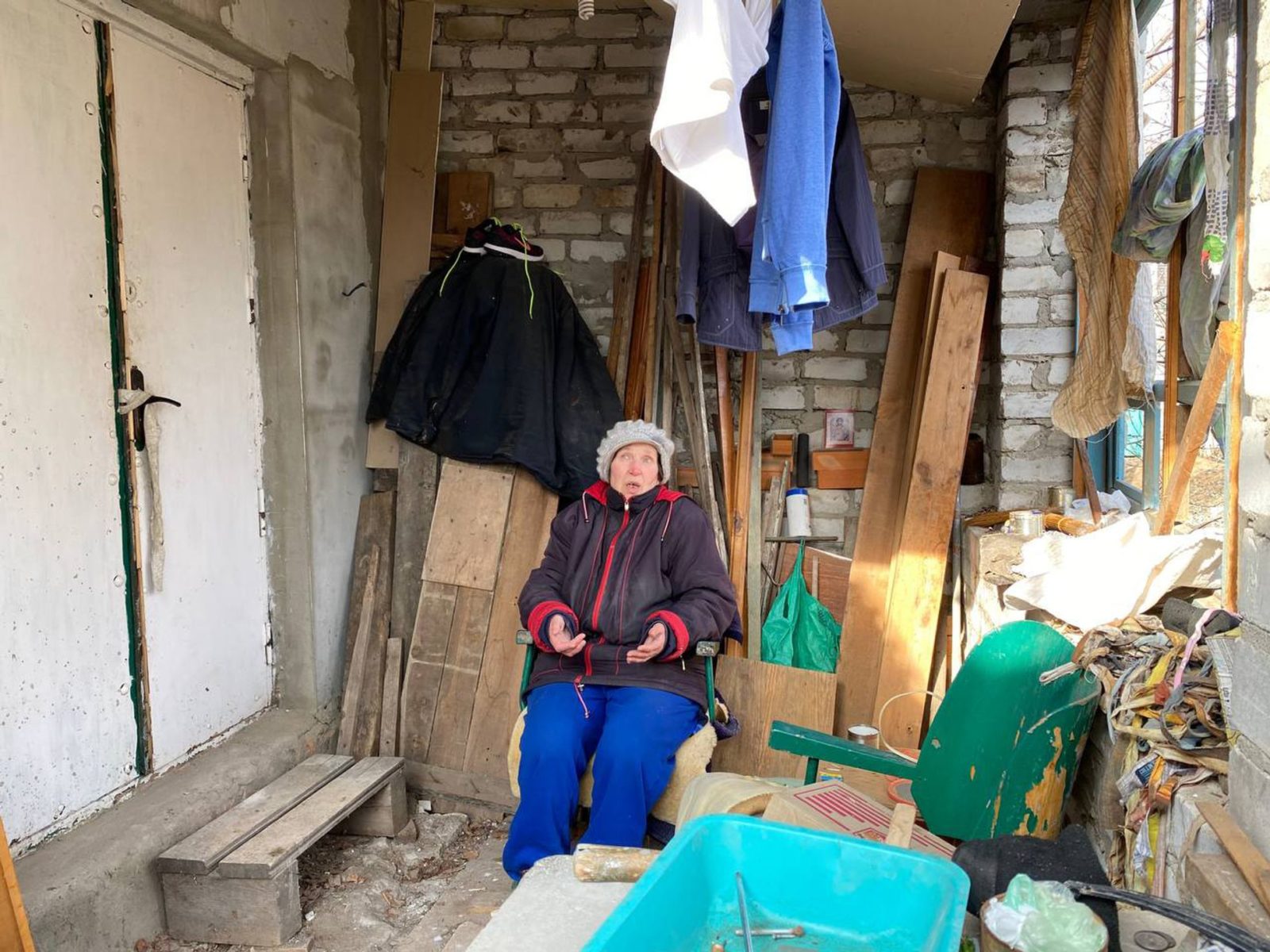
Nadia, Sasha’s wife
Elena Kostyuchenko / Novaya Gazeta
The Mykolaiv orphanage was evacuated immediately after the war began. There were ninety-three children living there, aged three to eighteen, all “social orphans,” children with living parents who cannot look after them. The children were taken to Antonovka, a village forty-one miles northwest. Five days ago, Russian troops assembled next to the village. On March 8, at 9:20 a.m., the troops fired on a car driving orphanage staff down the Kirovograd highway. Three women were killed.
Anatoly Geraschenko was the driver. He shifts anxiously from foot to foot. There’s a piece of shrapnel lodged in his right leg. “The surgeon said that they’ll operate if it starts to rot,” he says, but for now they’ve left it alone. Masha stays close to her father. One of her eyes is blue, the other one brown. “I’ve got three sons and two daughters,” Anatoly says proudly. He’s visibly shaking now, “It’s cold,” he says.
This was his third trip to Antonovka. He wouldn’t accept any money, only enough to cover the gas. He had stuck a red cross made of packing tape to his windshield. His van, a Mercedes Sprinter, burned along with the bodies inside.
“We made it past all the checkpoints, showing our passports every time. I had six women with me, and two in the back. At one of the checkpoints, they said something had gone down in the night. They shouldn’t have let us through!
“There was no oncoming traffic, just empty lanes. We made it about twenty-five kilometers. My vision’s not great, but two hundred and fifty meters out, the women spotted something, they tell me there’s something up ahead, something military. I said, ‘Ladies, what do we want to do?’ I slowed down. Then came the machine gun fire, I didn’t hear it or see anything. I only saw the gravel spraying out in front of me. Now I know why.
“I can’t remember exactly how they shot at us. Either I’d stopped completely by then, or maybe the van was still rolling a little. I didn’t see the blast, I only felt something shredding, dropping off of the van. A burst of light at my feet. I got out of the van, and they run over to me with their rifles. I’m lying facedown on the asphalt, screaming: ‘There are women inside! Women inside!’
“The Russians opened the back door—there were four more people in there. The women came out into the field. They ran over to them shouting, ‘Drop your phones!’ The women, four of them, all tossed their phones on the ground by the soldiers’ feet. I threw mine into the grass. I had a small one on me, in my pocket. My smartphone was still in the car, on the dashboard.
“When I go back to the van, it’s gone. I start looking for it. There was a woman sitting by the door—she had no face left. Just her guts out. Her finger was lying on the running board. Her face was gone! It was gone! And the woman sitting right behind me was dead, too, but her I didn’t see.
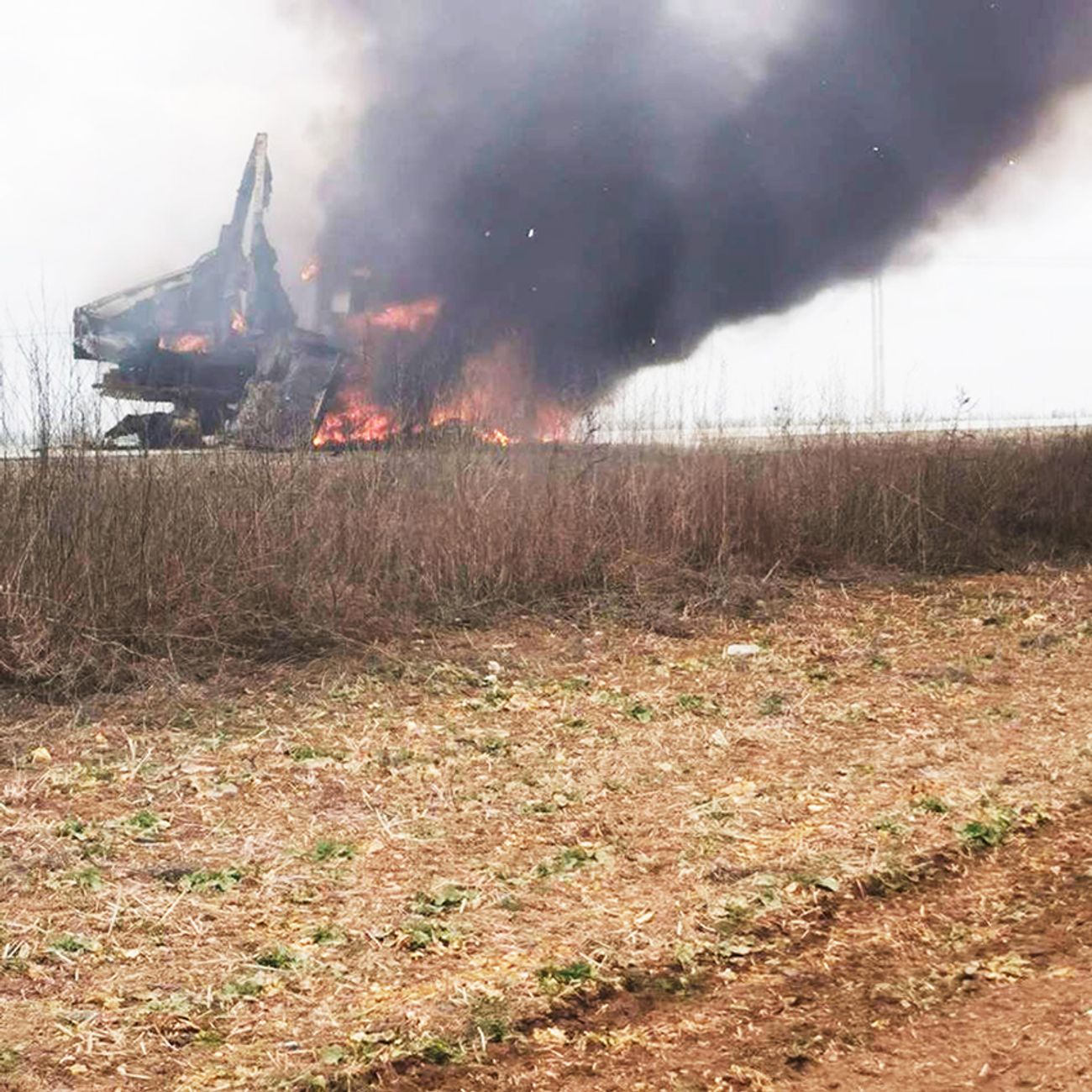
Burning car after shelling
Archive of Anatoly Gerashchenko
“The Russians are saying: ‘We warned you! We gave you a warning round.’ But I’m no soldier! Warning rounds aren’t the kind of thing I encounter every day. One of the women was wounded in the shoulder. They lifted her up onto her feet. One of the soldiers, a Yakut, or maybe he was a Buryat, bandaged her wound. The other one was very young, a kid, really. He had the same sunglasses as me. I remember his face. My leg was bleeding from all the shrapnel. This kid, he drew back when he saw me. Maybe he got scared or something. I said to him, ‘How do we get out of here?’ He says, ‘Take the fields. All the road signs have been taken down.’ I said, ‘We are going to walk on the road. If any of your men are up ahead, you tell them.’ They said, ‘We’ve informed them already.’
“They seemed completely indifferent, the Russians. They didn’t even care that the car was on fire, that there might still be people inside. I said to them, ‘Help me put it out, at least!’ They just stood there.
“I saw someone in the back lying there when the van first stared to burn. I got inside. It was this woman, her husband had seen her off, kissed her goodbye. I pulled her out—another woman helped me. We laid her out on the road and her back was all bare. I’d been dragging her by her jacket. Her back was shredded with shrapnel. I didn’t check her pulse or anything. Her husband called me today. I told him, ‘She didn’t burn, I pulled her out. . . . She’s still lying there.’
“There were two bodies left inside, they burned with the van. That car really burned. My birthday is November 11. And now it’s March 8, too.”
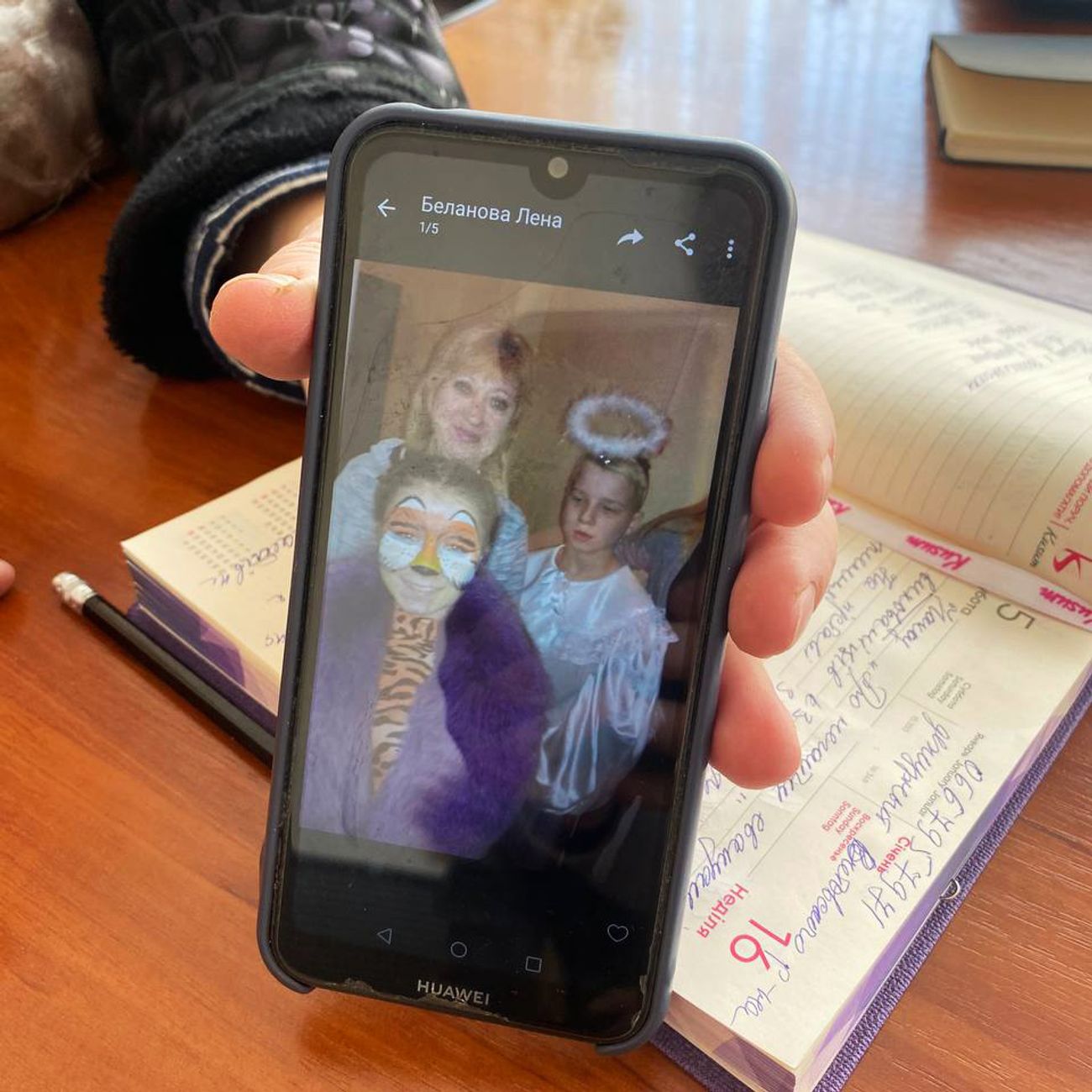
Principal Svetlana Klyuiko shows photos of the dead teachers. In the photo – Elena Alexandrovna Batygina
Elena Kostyuchenko / Novaya Gazeta
The three women killed were Natalia Mikhailova, Elena Batygina, and Valentina Vidyuschenko. The director of the orphanage, Svetlana Kluyko, tells me about each one of them: “Natalia Mikhailova, she’s been with us since 2014, a teacher. She used to work at a special-needs school so she was very experienced. She was the best sort of human being, kindness personified. If only there were more like her. She loved children, she was so wise, so good with her hands. All of my staff are excellent, but she in particular found a way to get on with everyone. She looked after the older boys. She would have been fifty on May 4. We were going to throw her a party. Elena Batygina took care of the little ones, dressing and changing them. Her children were always dressed so nicely. She had a big stock of different outfits, and party dresses. The children loved her, too. She was so kind. Twenty years with the orphanage. She was sixty-four. Valentina Vidyuschenko, she hadn’t been with us long. It was her second year as a teacher’s assistant. She was working with the new intakes, one of the most difficult groups. . . . When the children first come to us, they’re in tears. . . . They’ve been dropped off somewhere strange, it’s so stressful for them. She was one of the first people they met. She helped them wash, dressed them, changed them, talked to them, made them feel better. That’s the sort of people they killed. The children were inconsolable. They had been waiting for the teachers to come, we’d told them that they were on their way. The children screamed and screamed and wouldn’t stop.”
It was not possible to collect the bodies—or rather, what was left of the bodies: “We can’t get to them.” They remain where they were, fifteen and a half miles from the nearest Ukrainian checkpoint.
The wounded are in the Mykolaiv hospital: Anna Smetana, another teaching assistant, and Elena Belanova, a psychologist. The others, Galina Lytkina and Natalia Vedeneeva, have also been hospitalized, with “severe psychological trauma.”
Ninety-three children and ten teachers await evacuation farther into Ukraine in a village encircled by Russian troops.
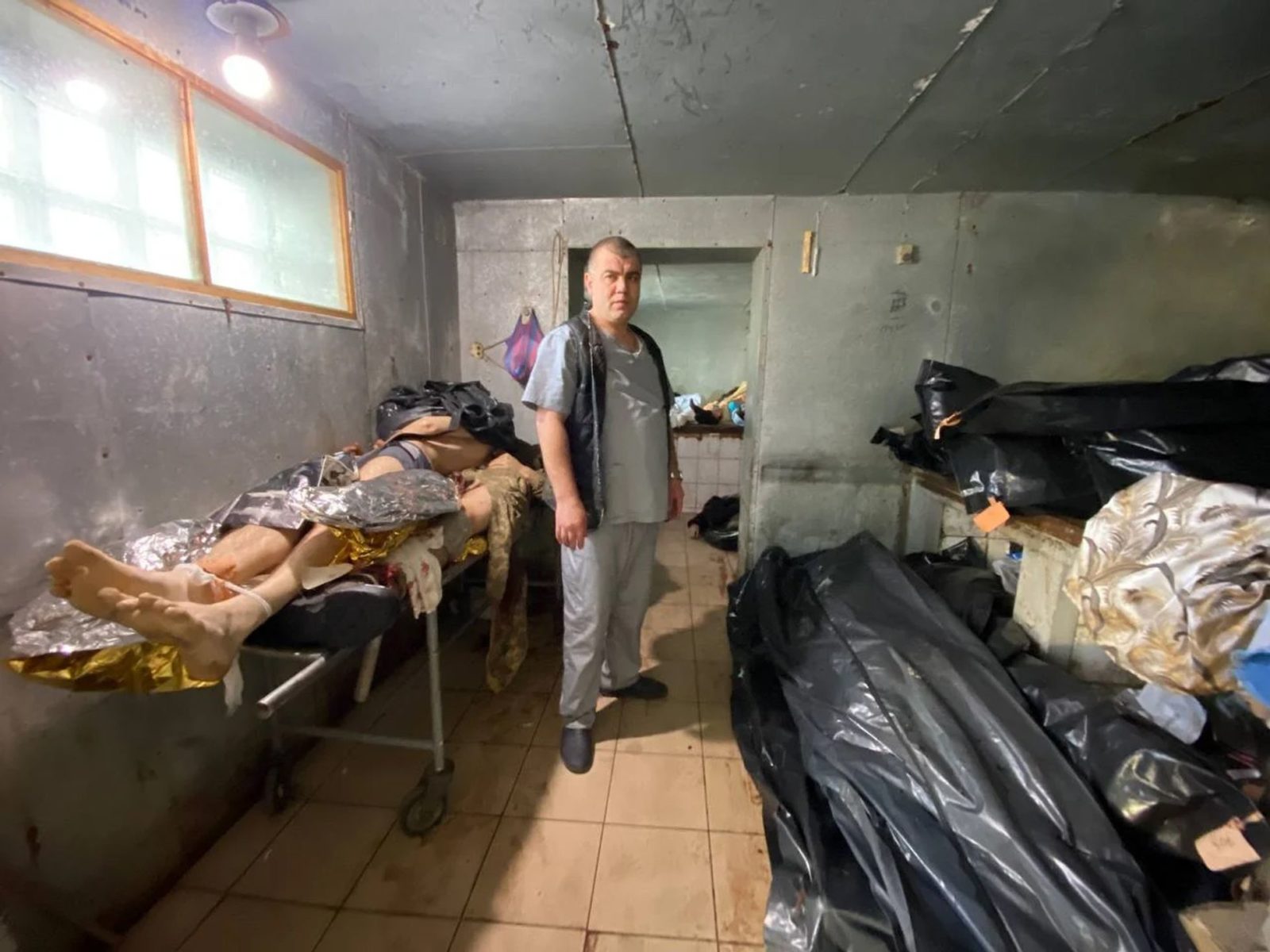
Orderly in the mortuary bureau of forensic examination
Elena Kostyuchenko / Novaya Gazeta
All the dead pass through the office of the regional medical examiner. According to Olga Deryugina, its head, since the start of the war they have processed over sixty bodies of Ukrainian soldiers and more than thirty civilians. When I ask for the exact numbers, she replies: “What’s the point? New ones arrive every day.” Each body is examined by a team of investigators preparing to file documents with the International Criminal Court at the Hague.
“We’ve never had so many bodies at once. Shrapnel, bullet wounds, bomb blasts . . . shrapnel, mostly. We’ve had two corpses with unexploded munitions, the bomb-disposal technicians had to come out to defuse the bodies.”
“That’s right, there was an unexploded ordnance attached to the body, I removed it myself,” says Yuri Aleksandrovich Zolotarev, one of the medical examiners. “It hadn’t gone off because the fuse was damaged. I pulled out the casing to give to the bomb-disposal experts so that they could examine it. I told the women to stand back. . . . These had been soldiers. . . . I pulled it out very carefully and handed it over to the bomb-disposal technician. The fins were up inside the rib cage, but the fuse was inside the stomach—it hadn’t blown up because the stomach walls are too soft. That was when they were shelling Ochakovo—these were mostly bodies from there. . . . The other guy, it was only a part of an ordnance. When the women came to identify them, the wives, the way they wailed, I haven’t heard anything like that in my twenty years on the job. I was in the Bosnian war—I never saw such savagery. Two of our soldiers I autopsied—it wasn’t enough that they finished them off with bullets, they also had to knife them in the back. . . . On March 6, two young guys went over to the aircraft repair facility, to try to torch it with Molotov cocktails. . . . The soldiers caught them, tied them up, shot them in the head, and then finished them off by stabbing them in the back. They had knife wounds, dagger wounds under the shoulder blade. It’s barbaric, taking the wounded and finishing them off like that.”
“First they shot them and then they finished them off?”
“I’ve been a medical examiner for twenty years! I know which of those wounds came first.”
The bodies are piled up in two sections of the cold storage. But there isn’t enough room in there, so the ones that have already been autopsied are stacked outside in the street, beside the wall. Eight of them, in black body bags. An outbuilding that was used as a shed before the war is now full of bodies, too—two rooms, each of them sixty-five feet across. There are bodies all over the floor. Five Russian soldiers lie in a corner. “We’re keeping them while it’s cold outside. Nobody knows who we should hand them over to, or how.
“These are all war fatalities, the burn victims are already body-bagged. . . . Step over them, don’t be scared. I’ve got some others here, too. Once we’ve worked them over, we have to pack them up in these black plastic bags, because, to be honest, there’s nowhere to put all the autopsied bodies, you’ve seen the state of the rooms.”
There are bare feet and feet still wearing shoes. Here is a scorched, blackened young man on his back, arms spread wide, a charred black mess for a face. Half of a human body, flesh fused with grass, a jacket covering the head, and a man’s hand hanging down from under the jacket. A naked man wrapped in a floral sheet. A Russian soldier with his hands behind his head; his camo jacket is riding up and you can see a clean undershirt and the yellow strip of his belly.
The bodies in the cold storage are stacked up in layers. Two girls lie one on top of the other. They are sisters. The older one is seventeen. All I can see in the heap of bodies is her hand, her slim, long fingers with neat pink nail polish. The younger girl is three years old and lies on top of her sister. She is blond. Her jaw has been tied shut with gauze, her hands tied together to rest on her stomach. Little red wounds from the shrapnel cover her body. The girl looks alive.
Arina Butym and Veronica Birykova. Same mother, different fathers. They came in on March 5, at five p.m. They’re from the Meshkovo-Pogorelovo village, Shevchenko Street.” Nikolai Chan-Chu-Mila is an orderly here. He doesn’t look at me when he speaks. “I’m their godfather. . . . I did their baptisms. We’re old friends. They brought the girls in during my shift. Of course I recognized them straightaway. I can’t describe what I went through when I first saw them.”
Dmitry Butym is the girls’ father. He waits on the other side of the fence, he’s taking their bodies home today. Deep red folds rim his eyes. “Vera was heating up food in the kitchen. Arina had gone out to play in the yard. They didn’t have a chance, either of them. The little one died instantly, a piece of shrapnel through the heart. The older one, they got her heart going for two minutes, but it wouldn’t beat on it own. Their mother is in the Dubki hospital, she has shrapnel in her thigh—it damaged things as it went through. You have to excuse me, all I can think about right now is burying my children.”
There’s a new body being brought in. The attendants are unwinding a striped bedsheet. It’s a man, the breathing tube still in his throat and his body flayed. Somebody tried to save him but couldn’t. He is left to lie in the yard.
Four men with dark roses are waiting for their colleague to be released to them. Igor was a security guard, a civilian. “That goddamn Tornado comes down, and that’s it.”

Elena Kostyuchenko / Novaya Gazeta
A body in camo trousers is carried out from the shed. The body is purple, with a wide gash where a face should be. Two men from the investigations unit bend over him. They take down a description of his clothes, remove his trousers, take a DNA sample by dipping a piece of gauze in his blood. One of them pokes his fingers into the crushed mess of the man’s mouth—they need to establish which of the skull bones are broken.
A light-haired woman wrapped in a black headscarf speaks: “My mother lived on the fifth floor. She couldn’t get down to the bomb shelter in the cellar. Her next door neighbors, they helped her, they were like family. She died in the morning, peacefully. As much as you can call it peaceful—she was on the bathroom floor, hiding from all this horror. The next day, at exactly the same time, a rocket hit the building next door and blew out all of her windows. But she was already gone by then. I think it was some kind of miracle, that she died peacefully on the Sunday. The next day she would have died in a state of terror. She was seventy-seven. I have a photo of the apartment, what was left of it, from the neighbors. This is the view from her window, the building next door that was hit. It was the next day, she wouldn’t have survived it. She died on Forgiveness Sunday. And on the seventh all of her windows burst. She would have been so frightened. If it had to happen, I’m glad it was on the sixth and not on the seventh. I’m so grateful. My mother was named Svetlana Nikolayevna. She was half Russian. Her husband, my dad, was born in Russia, in Krasnoyarsk. He was stationed here, that’s how they met. My maternal grandfather was from Kursk. We were a Russian-speaking family. We’re going to the cemetery now. My son is in Kyiv. My name is Oksana.”

Barracks of military unit A0224 after shelling
Elena Kostyuchenko / Novaya Gazeta
Army base A0224 is one of the two military installations at Mykolaiv that was hit by artillery fire. On March 7, at 5:15 a.m., the barracks were struck by a Caliber rocket. Nine dead, including five conscripts who had not yet seen fighting. Fourteen wounded. Two of the conscripts initially presumed missing in action were found several hours later—they had fled and hidden.
A chunk of a three-story building has been reduced to rubble. There’s a bunk bed still sitting on an intact bit of floor. Emergency responders dig through the rubble by hand. They work with the military personnel, passing the pieces up a human chain. They are searching for the body of the last missing man. His name was Stas. He was a native of Western Ukraine and had been drafted eight months ago.
Yaroslav, the press officer, had a lucky escape that night. He is squinting at the sun, his hands never not on his rifle. “They sounded the alarm at about five fifteen. I shot up and shouted, ‘Boys, everyone out!’ We were the first ones out of the barracks, we didn’t even put our boots on. . . . There were guys standing outside, and I told them to get inside. God forbid that they hit us with something, the shrapnel would go everywhere. . . . I started to go back inside. I ran back in and when I got to the second floor, maybe seven meters from me, I saw the tiles flying up, then a flash—fire. I saw fire. At five seventeen they hit us.
“I was knocked back by the blast. I covered my head with my arms. There was glass raining down on me. I try to turn on my . . . Fifteen seconds pass and I turn my flashlight on and I’m crawling. I can hear people screaming, a woman was screaming. I’m crawling and crawling, but I can’t feel the ground under me anymore. There is no ground. I hear the sergeant shouting, ‘Everybody outside!’ I managed to get back and started to run out. I had my rifle with me. Everybody I saw, whoever was left, I told them: ‘We have to get down to the shelter.’ And that’s how we made it out. Taras, Danila, some of the other guys, they were all buried under the rubble. There had been twenty-nine of us in the sleeping quarters.
“I don’t want to start cursing . . . but I’m not taking prisoners, not after this. And I don’t care about their parents or wives. I don’t feel any pity. I’m twenty years old, I was training to be a veterinarian, but I don’t have any pity left for anyone.”
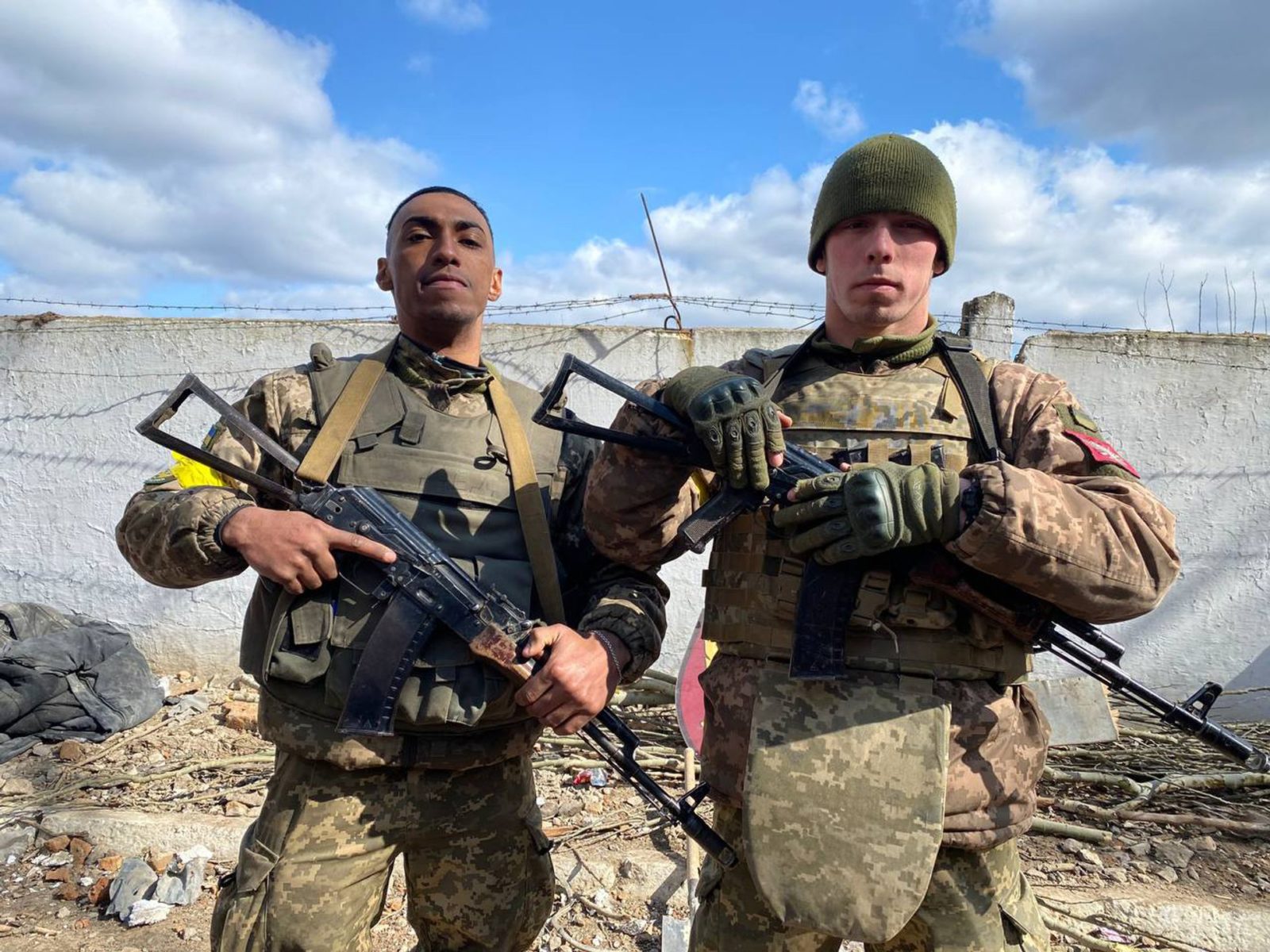
Anthony and Yaroslav
Elena Kostyuchenko / Novaya Gazeta
Somewhere up at the front lines, the Ukrainians have shot up a Tiger infantry mobility vehicle. Its Russian crew of four has surrendered. At HQ, they think that the Russians were doing reconnaissance, but those who were actually there think the Tiger was probably just lost.
Arthur has a black bandanna over his face. In his former life, he was a specialist in economic cybernetics. “There was a car driving up from the direction of Kherson. When it got here, I saw it was armored. They rolled down a window. I look inside: Russians, in uniform. I say, ‘Surrender.’ I cursed at them, too. The guy rolls the window back up before I could shoot. I started shooting out their tires. The car rolled for maybe another twenty seconds. Somebody threw a grenade and the car burst into flames. They didn’t want to come out at first. We smashed the windows in, and then they began to surrender.”
“Did you talk to them?”
“We tried not to. These terrifying warriors. All our guys were laughing their asses off. It was the usual bullshit: they thought that they were just doing military exercises, all of that crap. ‘I don’t even know where I am.’ Total bullshit, of course they know.”
They handed the prisoners over to the Security Service.
Someone has graffitied “Death to the enemies” on the dividing line in the middle of the road. The soldiers are warming up by the wood-burning stove. “Those Russians fucked up our spring.”
“I heard that it came from those towers,” says a soldier nicknamed the Actor. “A sniper or a machine gunner, I don’t know for sure. One bullet hit forty centimeters from my foot. After the third bullet, I finally clocked that they were aiming right at me.”
“Are you waiting for them to storm the city?”
“I’m waiting for all this fuckery to fuck back off. And I hope that the residents of the occupied territories are making plenty of Molotov cocktails. And I’d like to wish my daughter happiness. She’s three. I named her Maria.”
“My family stayed. My brother’s house is a little bigger than mine. We all live in the same village—my brother, our mother, and me. My brother is older, so he’s the head of the family, you know how it goes. His job is protecting the women and children, my job is to be here. I was in Varvarovka when they shelled the Kulbakino air base, working at a shipbuilding plant. My uncle woke me up at six thirty, and we could hear the air base being shelled. I was at the central recruiting office by eight twenty. They gave me my enlistment papers and said to come back at six o’clock the next morning, all packed. I only told my wife after I got back. She knew, though—she knew I would do that.”
“Where could we evacuate to? This is our land,” says another soldier. “My family is in Odessa. They won’t touch Odessa while Mykolaiv is standing. That’s why I’m here.”
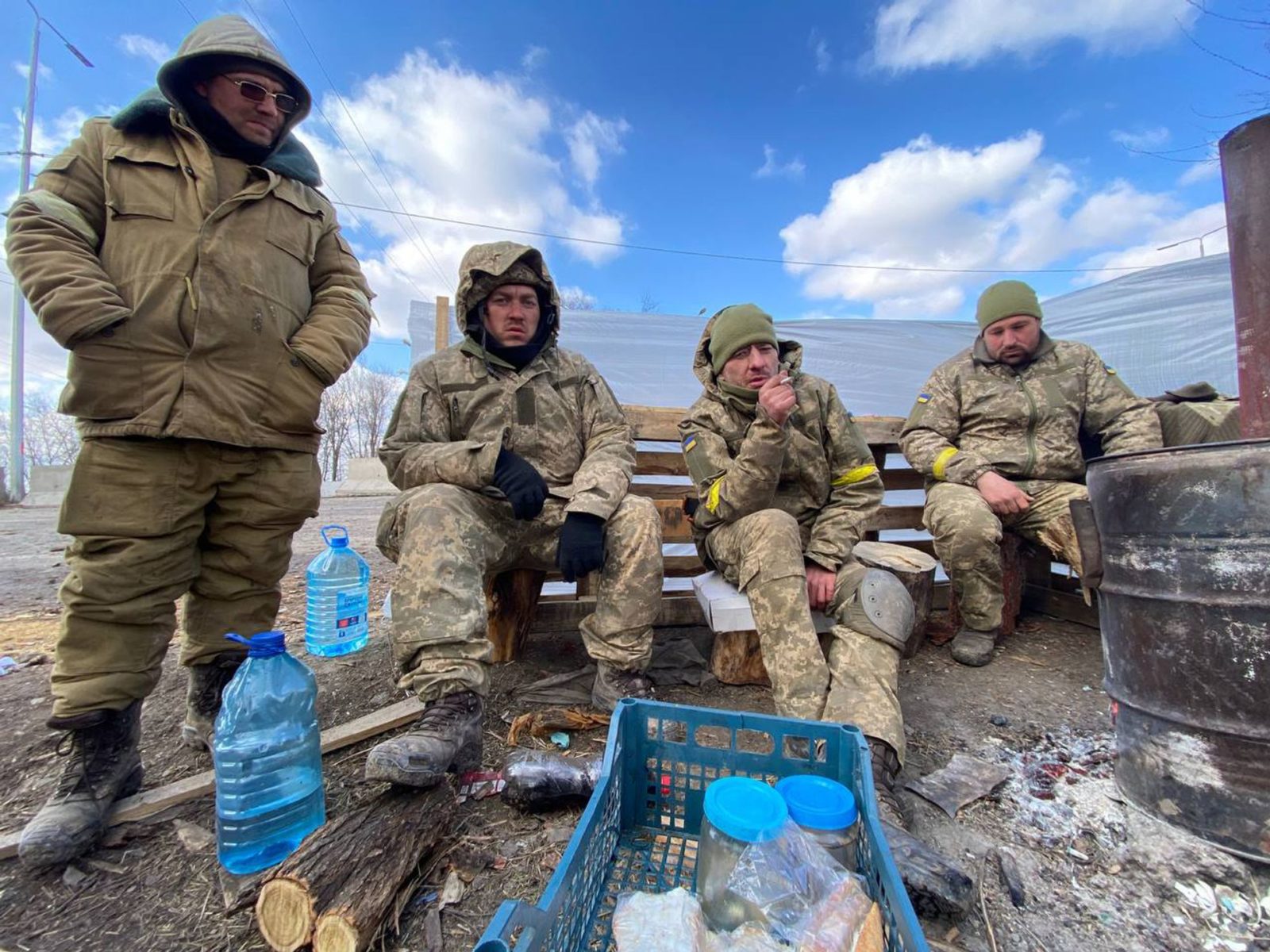
Ukrainian military
Elena Kostyuchenko / Novaya Gazeta
“We keep saying: ‘Russians, go home! Just go home, that’s it. We didn’t ask you to come here. You don’t have to die here.’”
“Why won’t they collect their corpses? They’re just fertilizer for our fields. So sorry, but your son will come here and you’ll never see him again, no neat little grave for you to visit. Something happens to me, though, my mom will grieve for me and bury me herself.”
“People who used to be like brothers to us are our enemies now, because they attacked us—that’s not what brothers do. We have to defend our land, we have to stand our ground. We didn’t want this war, we didn’t see it coming.”
“I’m from Mykolaiv myself. Am I supposed to just sit home and wait? I went down to the recruitment office on the very first day.”
“We don’t want to wage war against Russia. So don’t you come and wage war against us.”
“They think Ukraine is weak. No. Ukraine is really good. We know every hole and every burrow here. This is our land you’ve come to.”
“We don’t want war. We want you to leave us alone.”
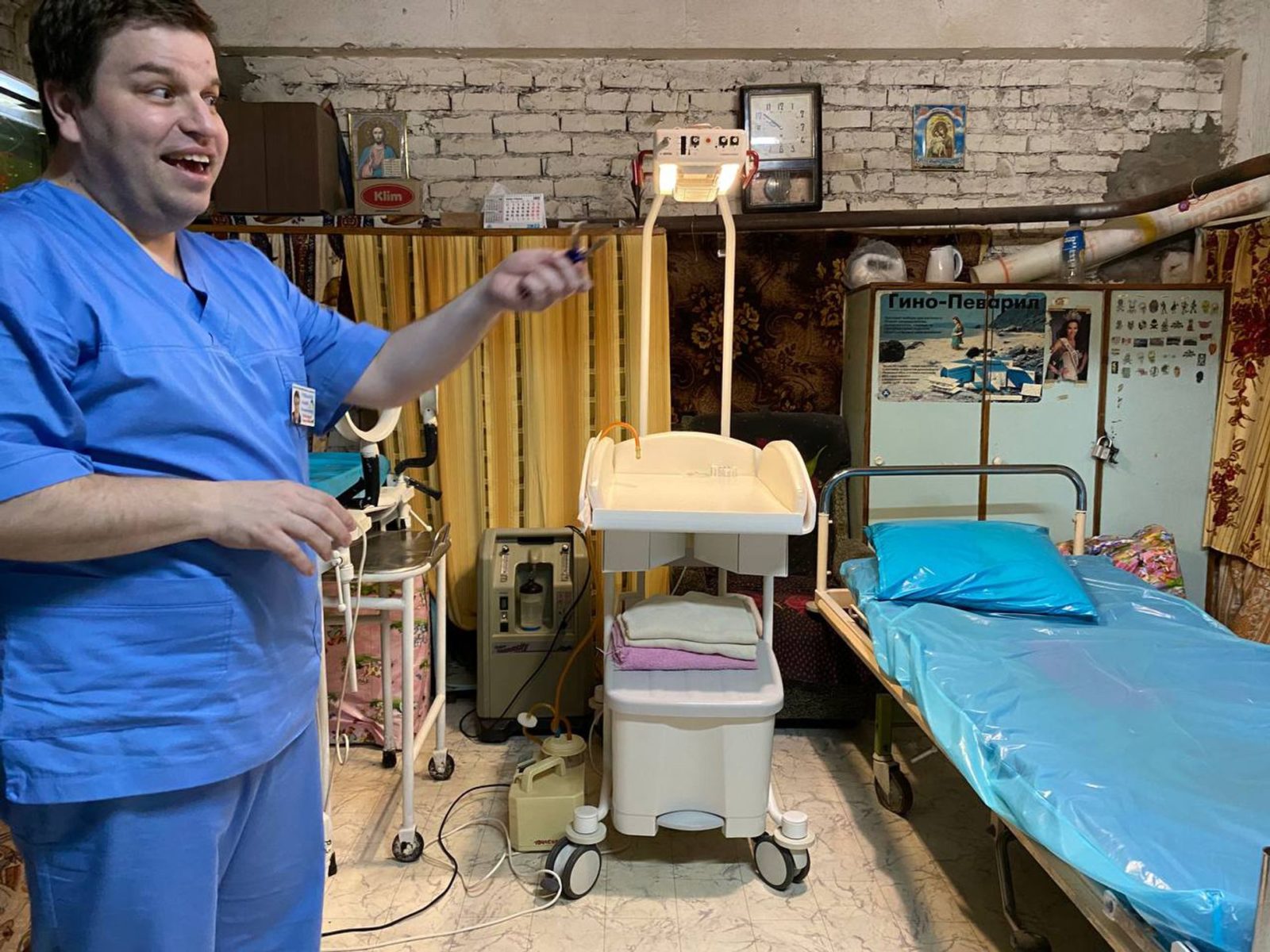
Maternity room in the basement of maternity hospital No. 3
Elena Kostyuchenko / Novaya Gazeta
So far, twenty-two babies have been born at the Mykolaiv maternity hospital No. 3 during the war, two of them in the makeshift bomb shelter in the basement. All of the babies survived.
There are almost no C-sections anymore, because the stitches need rest, peace, and quiet, and there’s no peace now, not with the air raids. A maternity ward has been set up in the basement, but the operating rooms are still on the third floors. This is very dangerous. A siren blares. Expectant mothers walk down to the basement, step by step, holding on to the walls, their descent slow and ponderous. The midwives carry the babies down.
Lena Sylvestrova lies on a metal gurney under a woolen blanket. Her husband, Aleksei, is trying to soothe her. The palm of his hand is on her neck. Lena gave birth at 4:30 a.m. by C-section. She had tried for a natural birth, she labored for almost twenty-four hours. She is twenty-eight and her husband is twenty-six. This is their first child. She went into labor early in the morning, after curfew. Aleksei drove her to the hospital himself.
“My due date was just around when the war started. I was so worried, waiting for it all to kick off. I was constantly on edge, waiting. Worrying that we’d get caught in an air raid or shelling in town. I was lucky—they managed to do my C-section between two air raid sirens. Imagine, you are in labor, all you want is some peace and quiet for your baby, but instead, your city is being endlessly bombed!”
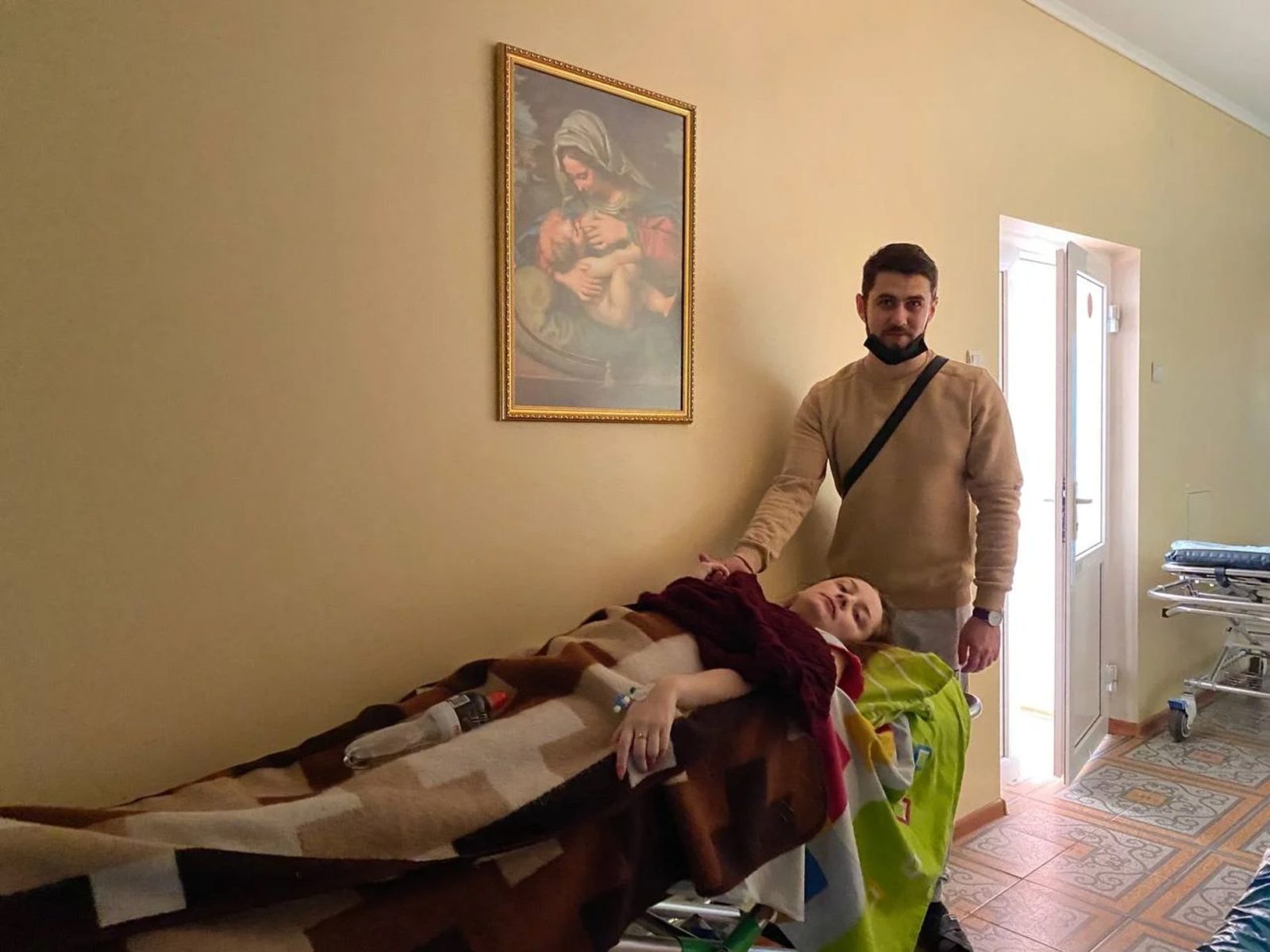
Alexey and Lena, a young mother
Elena Kostyuchenko / Novaya Gazeta
Aleksei strokes her cheek.
“I’d love to remember what it’s like, walking around without worrying about getting shot.”
The light in the basement is dim, the women sit along the walls. The chief physician takes Aleksei to the archive department and quietly opens the door. Inside, a midwife sits on some mattresses and cradling a white bundle. She holds the bundle out toward Aleksei. “I don’t want to hold it, I’m scared,” he tells her.
“Better get used to it. Don’t be scared, nothing to be afraid of.”
Aleksei holds Masha in his arms. It’s his first time. The midwife gently adjusts his hands.
“She’s so tiny,” Aleksei says. He falls silent, his face dipping ever closer to his daughter’s. “My little girl. Hello there! Are you sticking your tongue out at me? Really, Masha? We’re going to be together every day, every single day, deal?”

Alexey and newborn Masha
Elena Kostyuchenko / Novaya Gazeta
We only want peace. Please write that,” says a woman in a white lab coat. “My name is Nadezhda Sherstova. I’m a senior nurse anesthetist. I’ve been doing this job thirty years. Since the war started, whenever a baby is born, there’s no joy in the parents’ eyes. You worry about the mothers, their milk coming in. That’s what scares me. There is no joy for the parents.”
“She was a real pain,” Aleksei tells the chief physician. “Constantly kicking. She’d hear my voice and start in on her dancing in there. Wouldn’t let her mom sleep at night. She’s kicking a little right now. I thought she would look like me. When we did the ultrasound, they said she looked like me, but look how pretty she is.”
The next shelling of Mykolaiv began at 8:00 p.m. on March 11 and lasted most of the night, with brief pauses. According to Mayor Oleksandr Senkievich’s official statement, more than 167 residential buildings sustained damage, including City Hospital No. 3 (which was filled with wounded civilians), a prepared-food plant, eleven schools and day cares, and an orphanage. Eleven private homes were completely destroyed. Shrapnel shredded the yard of the cancer ward and the emergency department. Kuzya, the beloved hospital guard dog, was killed. They covered him up with a towel. The cemetery was shelled, too. Fires have broken out all over the city.

